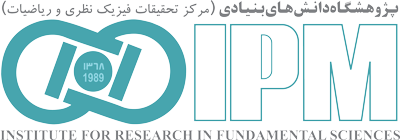“Rouzbeh Torabi”

IPM Positions |
||
|
Long Term Visitor, School of Biological Sciences
Non Resident Researcher, School of Mathematics (2024 - Present ) |
||
Past IPM Positions |
||
|
Associate Researcher (non-resident), School of Mathematics
(2009 - 2010) (From October ) Associate Researcher, School of Mathematics (2002 - 2003) Post-Doctoral Research Fellow, School of Mathematics (1999 - 2001) |
||
Research Interests |
||
| Combinatorics and Computer Science: Algorithmic method in Design Theory and Graph Theory, Probabilistic methods in Combinatorics, Algorithm and Computational Complexity, Languages and Automata, Coding Theory and Cryptography and their links | ||
Research Activities |
||
|
A Cryptosystem is a five-tuple (P,C,K,E,D),
where the following conditional are satisfied: 1. P is a finite set of possible plaintexts 2. C is a finite set of possible ciphertexts 3. K, the keyspace, is a finite set of possible keys 4. For each K ? K,there is an encryptionrule eK ? E and a corresponding decryption rule dK ? D. Each eK:P?C and dK:C?P are function such that dK(eK(x))=x for every plaintext x ? P. In the classical model of cryptography people secretly choose the key K. K then gives rise to an encryption and decryption rule (eK and dK). In these systems that is named private-key systems, dK is either the same as eK, or easily derived from it. The idea behind a public-key system is that might be possible to find a cryptosystem where it is computationally infeasible to determine dK given eK. If so, then the encryption rule eK could be made public by publishing it in a directory. The idea of a public-key system was due to Diffie and Hellman in 1976. The first realization of a public-key system came in 1977 by Rivest, Shamir and Adleman (who invented the well-known RSA-Cryptosystem. Since then several public-key systems have been proposed, where security rests on different computational problems. the McEliece Cryptosystem is based on algebraic coding theory. It is based on the problem of decoding a linear code (which is NP-complete). And the Merkle-Hellman Knapsack-Cryptosystem and related systems are based on the difficulty of the subset sum problem( which is also NP-complete). Since there are many hard problems in combinatorial design and related topics, we want to use these problems to generate new kind of cryptosystem. |
||
Present Research Project at IPM |
||
| Application of Combinatorial Design in Cryptography | ||
Related Papers | ||
| 1. | C. Eslahchi. , H.R. Maimani. , R. Torabi. and R. Tuserkani. Proper nearly perfect sets in graphs Ars Combinatoria (Accepted) [abstract] | |
| 2. | C. Eslahchi. , H.R. Maimani. , R. Torabi. and R. Tuserkani. Dynamical 2-domination in graphs Ars Combinatoria (Accepted) [abstract] | |
| 3. | H. R. Maimani, R. Torabi and R. Tusserkani (Joint with Ch. Eslahchi) Dynamical 2-domination in graphs Ars Combin. (Accepted) [abstract] | |
| 4. | H. R. Maimani, R. Torabi and R. Tusserkani (Joint with Ch. Eslahchi) Proper nearly perfect sets in graphs Ars Combin. (Accepted) [abstract] | |
| 5. | H. R. Maimani and R. Torabi An algorithm for constructing two disjoint Hadamard designs Ars Combin. 73 (2004), 231-238 [abstract] | |
| 6. | H. Kharaghani and R. Torabi On a decomposition of complete graphs Graphs Combin. 19 (2003), 519-526 [abstract] | |
| 7. | G. B. Khosrovshahi, H. R. Maimani and R. Torabi An automorphism-free 4-(15,5,5) design J. Combin. Math. Combin. Comput. 37 (2001), 187-192 [abstract] | |
| 8. | G. B. Khosrovshahi and R. Torabi Maximal trades Ars Combin. 51 (1999), 211-223 [abstract] | |
| 9. | G. B. Khosrovshahi, H. R. Maimani and R. Torabi On trades: an update Discrete Appl. Math. 95 (1999), 361-376 [abstract] | |
| 10. | G. B. Khosrovshahi, H. R. Maimani and R. Torabi Classification of simple 2-(6,3) and 2-(7,3) trades Australas. J. Combin. 19 (1999), 55-72 [abstract] | |
| 11. | G. B. Khosrovshahi, A. Nowzari-Dalini and R. Torabi Trading signed designs and some new 4-(12,5,4) designs Des. Codes Cryptogr. 11 (1997), 279-288 [abstract] | |
| 12. | R. Torabi and G. B. Khosrovshahi A note on labelings of graphs Linear Multilinear Algebra 39 (1995), 165-169 [abstract] | |
| 13. | G. B. Khosrovshahi, A. Nowzari-Dalini and R. Torabi Some simple and automorphism-free 2-(15,5,4) designs J. Combin. Des. 3 (1995), 285-292 [abstract] | |
| [Back]
|



















